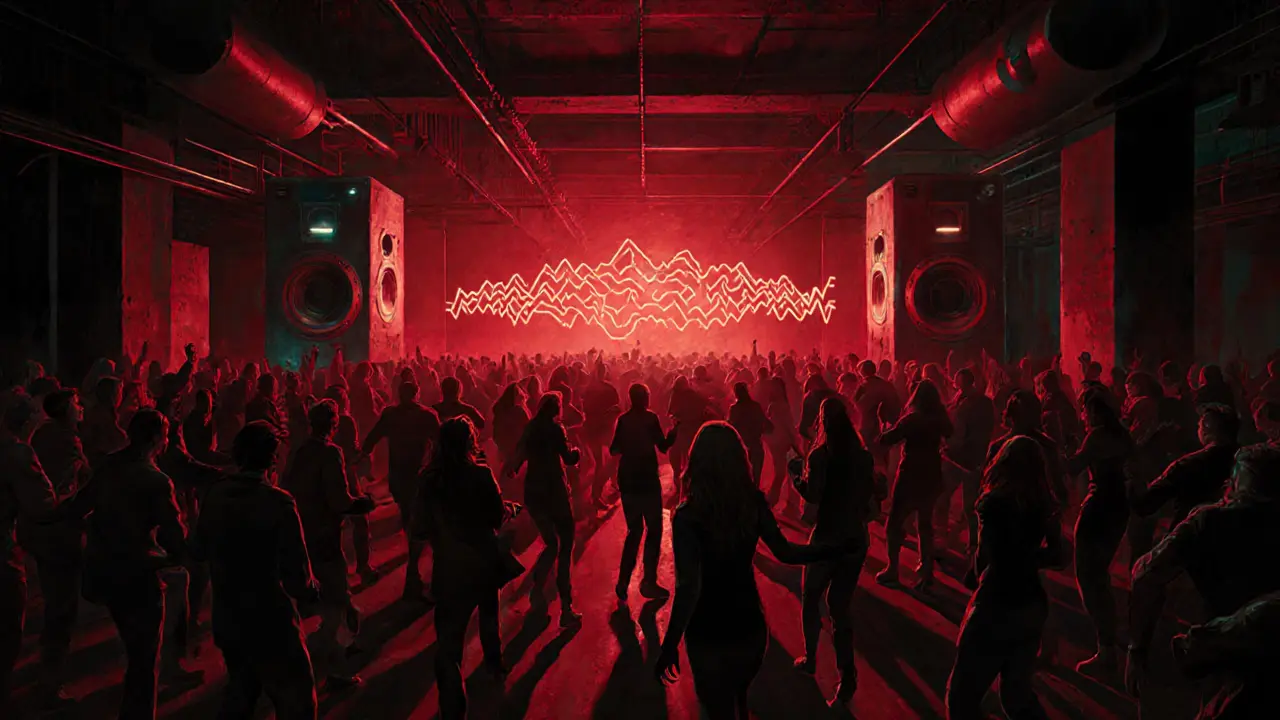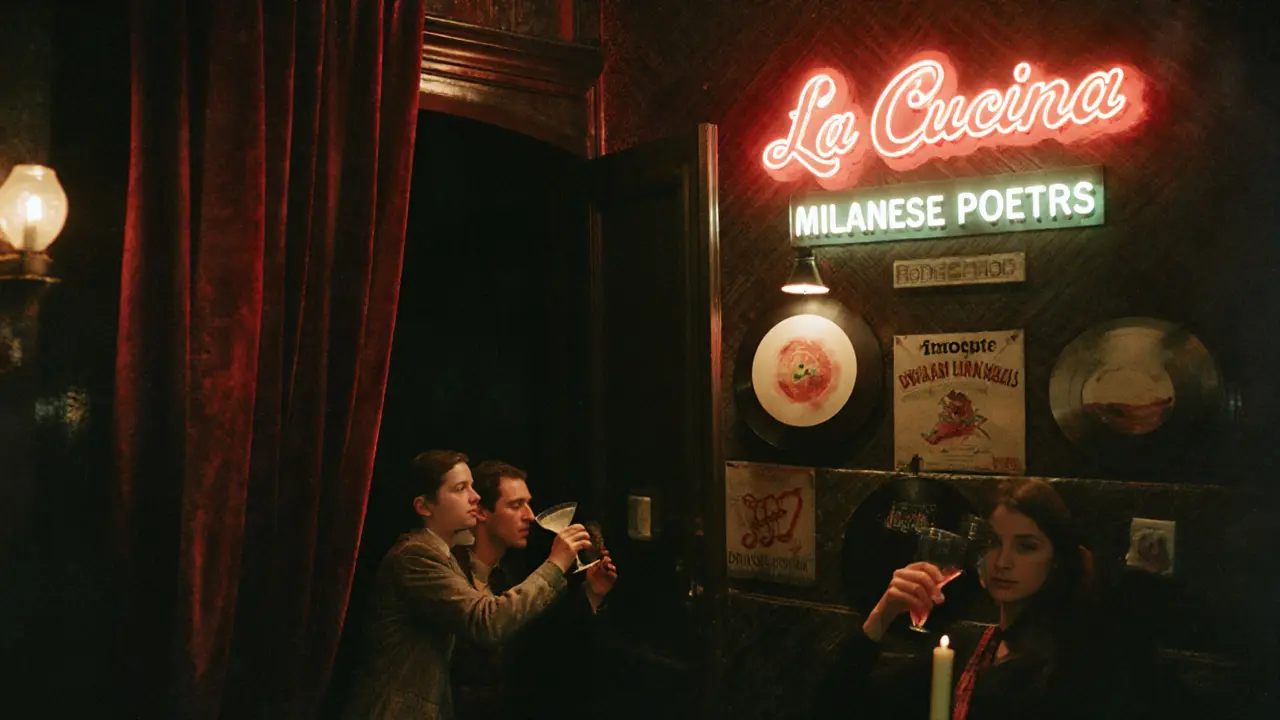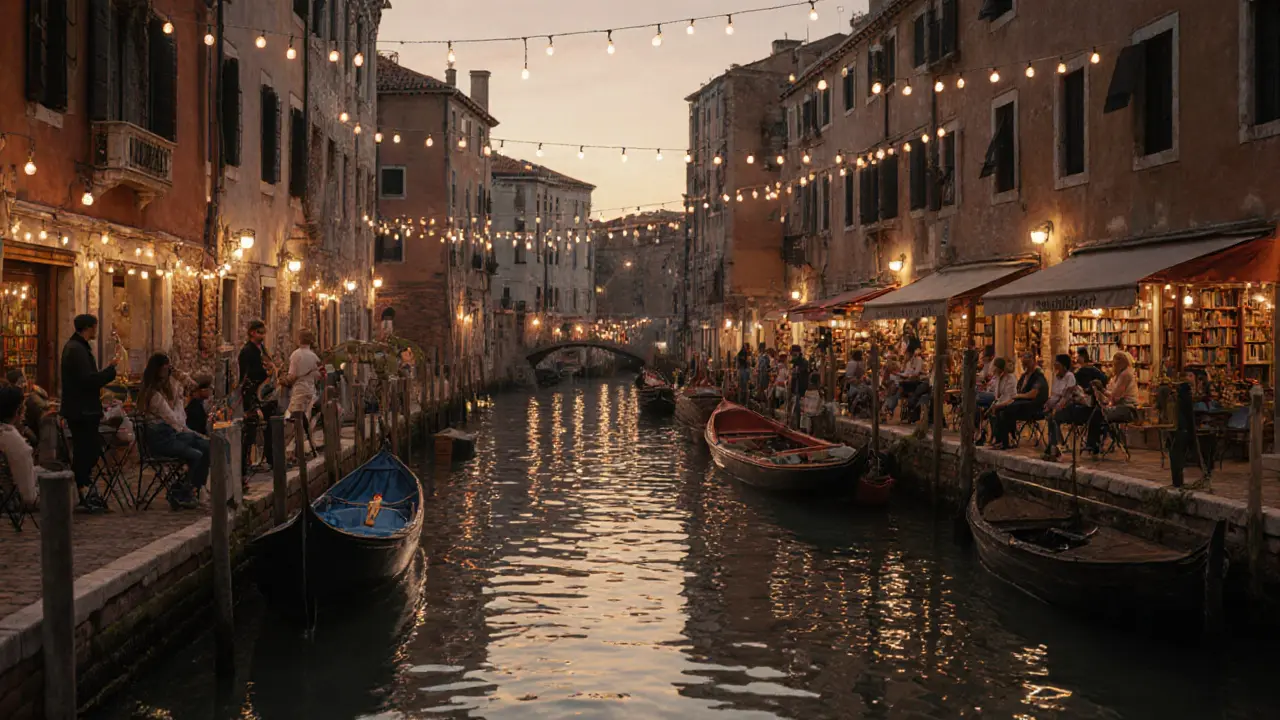When the sun sets over Milan, the city doesn’t sleep-it switches gears. The sleek, designer-filled streets of Brera and Navigli transform into pulsing corridors of music, laughter, and clinking glasses. This isn’t just a city that knows how to dress well-it knows how to party, too. Forget what you think you know about Italian nightlife. Milan doesn’t do slow nights or sleepy bars. It does energy, style, and a rhythm all its own.
Where the Night Begins: Navigli District
Start your night in Navigli, the canal-lined neighborhood that feels like a secret only locals and savvy visitors know about. By 8 p.m., the terraces along the Naviglio Grande are already buzzing. People sip Aperol spritzes under string lights, while live jazz or indie bands play from tiny stages tucked between vintage bookshops. This isn’t a club scene-it’s a neighborhood party that spills onto the sidewalks.By 11 p.m., the real movement begins. La Bitta becomes the go-to spot for craft cocktails and a crowd that mixes artists, designers, and expats. Their gin list has over 60 varieties, and the bartenders know exactly what you’ll like before you order. Nearby, Bar Basso-home of the original Negroni Sbagliato-still draws crowds, but it’s less about the drink and more about the history. This place opened in 1982 and still feels like the heartbeat of Milanese nightlife.
From Bars to Beats: The Club Scene
If you want to dance until sunrise, head to the outskirts. Milan’s best clubs aren’t in the city center-they’re hidden in old warehouses, industrial zones, and converted factories. La Scala Club (not to be confused with the opera house) is a weekly institution. Located near Porta Genova, it’s where underground techno meets Milanese elegance. No dress code, no velvet ropes-just a curated sound system and a crowd that moves like one body. The DJs here don’t play top 40 hits. They play tracks you’ve never heard but will remember for months.For something bigger, Magazzini Generali in the Porta Venezia area is a multi-level warehouse that hosts international acts. Last month, a Berlin-based producer played a 6-hour set that ended with the sunrise over the city skyline. The crowd? Mostly locals in black turtlenecks and vintage leather jackets. Tourists stick out-not because they’re loud, but because they’re still wearing sneakers.
Where the Locals Go: Brera and Porta Ticinese
Brera is where Milan’s creative class unwinds. It’s quieter than Navigli, but more intimate. Bars like Il Baretto and Bar Basso’s little sister, La Soffitta, serve wine by the glass from small Italian vineyards. You’ll find professors, photographers, and fashion students debating art, politics, or the latest collection from Prada. No one’s here to be seen-they’re here to talk.Just a 10-minute walk south, Porta Ticinese is where the real underground thrives. La Cucina is a speakeasy-style bar behind an unmarked door. You need to text a number for the code. Inside, it’s dim, cozy, and packed with people who’ve been coming here for 15 years. The cocktails are named after Milanese poets. The music? Rare vinyl from the 70s and 80s. No one checks IDs here-you’re either in or you’re not.

The Rules of Milan Nightlife
Milan doesn’t have a single nightlife culture-it has layers. Here’s what actually works:- Don’t show up before 11 p.m. If you’re at a club before midnight, you’re either early or lost.
- Dress like you mean it. Even in the most casual spots, ripped jeans and hoodies won’t cut it. Think clean lines, dark colors, and one standout piece-a leather jacket, bold shoes, or a silk scarf.
- Reservations matter. Popular bars like La Bitta or La Cucina take bookings. Walk-ins get turned away after 10 p.m.
- Don’t ask for vodka shots. You’ll get a raised eyebrow and a glass of sparkling water.
- It’s not about how late you stay-it’s about how you move through the night. Milanese nightlife is a slow burn, not a sprint.
What’s New in 2025
This year, Milan added two game-changers. Le Cantine, a rooftop wine bar with views of the Duomo, opened in April. It’s open until 2 a.m. and serves natural wines from Lombardy’s hidden vineyards. The second? Club 1969, a retro-futuristic space inside a 1970s bank vault. They play only analog synths and vinyl from the 80s. No digital decks. No playlists. Just pure analog noise.Also, the city finally cracked down on tourist traps. The old “Italian club” spots near the station that played Eurodance and charged €20 for a beer? Most of them closed in 2024. The new scene is authentic, local, and hard to find unless you know someone.

When to Go and How to Get Around
The best nights are Thursday through Saturday. Sunday is quiet-unless you’re in Navigli, where brunch turns into a late-night party with live acoustic sets. Weekdays? Only if you’re heading to La Scala Club or Magazzini Generali-they sometimes host themed nights on Wednesdays.Public transport shuts down at 1:30 a.m., so plan ahead. Uber and Bolt work fine, but many locals use the night bus (N1-N6 routes). Taxis are expensive but reliable. Walking is safe in the main districts, but avoid the industrial zones after 2 a.m. unless you know where you’re going.
What You Won’t Find in Milan
You won’t find EDM festivals in the city center. You won’t find karaoke bars or bachelor parties with neon signs. You won’t find 24-hour pizza joints that stay open after the clubs close-because Milanese people don’t eat pizza at 4 a.m. They eat panzerotti or arancini from a street cart, then head home.And you won’t find a scene that tries to be like Ibiza, Berlin, or New York. Milan’s nightlife is its own thing: quiet in the way it starts, loud in the way it ends, and always, always stylish.
What’s the best night to experience Milan nightlife?
Thursday to Saturday are the best nights. Thursday has a more relaxed, artsy crowd in Navigli and Brera. Friday and Saturday are when the clubs hit full power-especially La Scala Club and Magazzini Generali. Sunday mornings in Navigli turn into a slow, sunny party with live music and fresh espresso.
Do I need to speak Italian to enjoy Milan nightlife?
No, but knowing a few phrases helps. Most bartenders and club staff speak English, especially in tourist areas. But in places like La Cucina or smaller bars in Porta Ticinese, a simple "Grazie" or "Un altro, per favore" earns you better service-and sometimes a free snack. Locals appreciate the effort.
Is Milan nightlife expensive?
It can be. A cocktail at La Bitta costs €14-18. Club entry is usually €10-20, depending on the night. But you can find cheaper options: Navigli terrace drinks start at €8, and street food like panzerotti is €3-5. If you want to save money, skip the clubs after midnight and stick to bars in Brera or Porta Ticinese-where the vibe is just as good and the prices are lower.
Are there age restrictions in Milan clubs?
Yes. Most clubs require you to be 18 or older. Some, like Magazzini Generali, enforce a 21+ policy on weekends. ID checks are common, even if you look older. Bring your passport or EU ID card-driver’s licenses from outside Europe aren’t always accepted.
Can I go clubbing alone in Milan?
Absolutely. Milan is one of the safest European cities for solo nightlife. Locals are friendly but respectful of personal space. Many bars and clubs have single tables or counter seating. You’ll often find yourself chatting with someone next to you by the second drink. Just stay aware of your surroundings-especially near the canal edges at closing time.
What’s the dress code for Milan clubs?
Think "elegant casual." No sneakers, no hoodies, no shorts. Men: dark jeans, button-down shirt or slim-fit sweater. Women: tailored pants, dresses, or stylish separates. One statement piece-like bold earrings, a leather jacket, or designer shoes-is enough. You don’t need to look like a model, but you should look like you put in effort.
